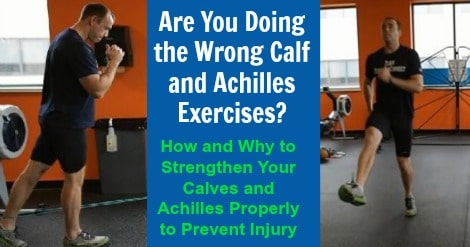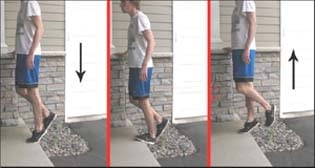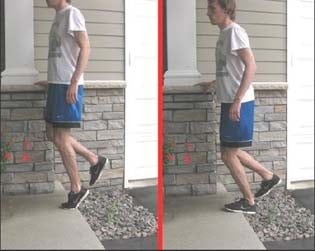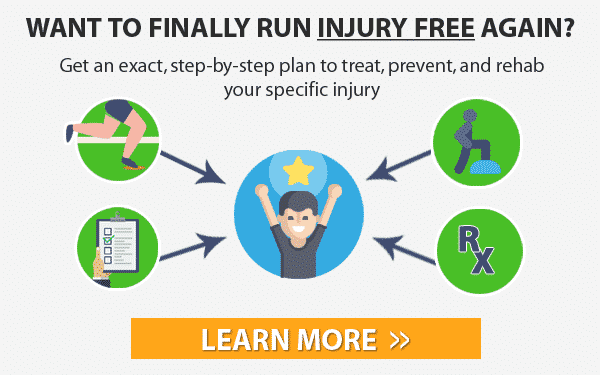Whether you have just started running in the last month or have been a runner for life, there are some muscles that can tighten up and cause us so much pain with every step that we wonder whether we should even keep running or shut it down and rest.
One of the major ones is your calf muscles.
Running is not exactly easy without our calf muscles working properly.
Once you have a tight calf muscle with a cramp-like feeling with every step, it becomes almost impossible to run without stopping to stretch every few minutes trying to loosen them.
Not exactly ideal for any runner.
It get’s worse:
Once you have very tight calf muscles, even walking becomes painful. Now it is affecting your daily life as well as your running.
Is there anything that can be done to relax it and prevent it from happening again?
If your calf-strength limits your running, you will try anything to get the muscle relief you desire, but there is a problem with finding the best calf strengthening exercises:
It seems like everyone has a different opinion about how to handle a tight calf from running, so how do you know who to trust?
Today, we are going to examine why your calf muscles get tight, how you can build a stronger lower body (calf, achilles and ankles) to help keep calf pain away, and how to stop getting injured because of your calf weakness.
So start doing the right exercises, and give your calves the support they deserve.

What are the Calf Muscles?
The calf actually consists of two muscles: the gastrocnemius and the soleus.
The gastrocnemius has two “heads” which make up the meatier upper part of the calf, while the soleus is the more slender lower part of the muscle.
Sore Calf Muscles from Running? Here’s Why (it’s not what you think!)
The misconception about the role of the calves during the running stride is that they assist in propelling the body forward at toe off, much like a traditional calf raise.
However, recent research and understanding of running mechanics shows this isn’t the case.
This is interesting:
The calf is most active as the foot contacts the ground and begins to generate hip extension to propel ourselves forward, not when you push off the ground.
This realization totally flips our treatment approach to calf injuries on its head.
After all, haven’t you been told after a calf injury to do calf raises and strengthening in this exact movement?
But, if the calf isn’t activated in this way during the running stride, how is it helpful?
Rather than performing calf raises to improve absolute strength, we need to look at how we can reduce the load on the gastrocnemius as the foot contacts the ground.
This is accomplished by improving running form.
Specifically, ensuring that you generate proper hip extension from the hamstrings and glutes so the leg passes under the body in a bent position, which takes pressure off the gastrocnemius.
How to Strengthen Calf Muscles to Prevent Injury
Since we now know that the gastrocnemius and soleus are not primarily activated or used at toe off, generic calf raises are not going to strengthen your calves for the specific demands of running.
Instead, we need to look at preventing calf injuries in two contexts:
First, strengthening the hips and glutes to ensure that you generate enough power to prevent the leg from being straight as it passes underneath the body.
Second, strengthening the calf muscles as they are used during running – when the knee is slightly bent and with pressure applied downwards (just like the exact moment your foot hits the ground and begins to drive back)
If you suffer from frequent calf strains, here is a series of strengthening exercises I recommend:
RunnersConnect Insider Bonus
Download our free Calf Strain Injury Prevention Routine!
It’s a PDF with images and descriptions of the most effective prevention and rehab exercises for runners who suffer from calf strains.
How to Prevent Achilles Injuries
The Achilles tendon is the thickest and strongest tendon in your body, connecting your calf muscles to the back of your heel.
The role of the Achilles and ankle complex: why you keep getting injured
The key power generator at push off is the ankle joint and Achilles tendon, not the quads, which is a common misconception.
If we observe the ankle joint during a typical stride, we can see clearly that it goes through an extensive range of motion, which helps the ankle joint and the connected ligaments and muscles, to act as a spring to generate power.
Virtually all of the force generated when you “toe off” the ground during running is transmitted by the Achilles, and this force can be as much as three times your body weight.
The faster you run, the more strain you put on the Achilles tendon.
Therefore, the primary cause of Achilles tendon injuries is related to excessive stress being transmitted through the tendon.
This can be made worse by bad running form.
When the Achilles attempts to make up for a lack of power being generated from the hips and glutes while trying to run fast, weak tendon structure, and poor ankle range of motion.
How to strengthen and prevent injuries
The main objective in strengthening the Achilles tendon should improving the strength and composition of the collagen – the small fiber-like proteins that make up tendons.
When a tendon is damaged, collagen fibers are ruptured. The body is able to lay down new fibers to replace the damaged ones, but it does so in a rather disorganized way.
The new collagen fibers look much like a mess of spaghetti when viewed on a microscope, in contrast to the smooth, aligned appearance that healthy tendon fibers have.
Therefore, exercises that can help strengthen the existing collagen and allow new collagen to form in a smooth, aligned manner are critical to maintaining Achilles tendon health.
The exercise of choice is the eccentric heel drop, which has an impressive research pedigree backing its use.
Also, you’ll want to improve your ankle range of motion and work on your hip, hamstring and glutes to ensure they are generating the proper power to take pressure off the Achilles tendon.
The same exercises outlined above are sufficient to improve hip, hamstring and glute strength, but here is how to perform the eccentric heel drop and ankle range of motion exercises.
Simple Achilles prevention exercise
Exercise 1: The straight-knee eccentric heel drop.

In this picture, the injured side is the left leg. Note that the right leg is used to return to the “up” position. Once you can perform this exercise pain-free, add resistance using weights in a backpack.
Exercise 2: The bent knee eccentric heel drop.

As with exercise 1, the opposite leg is used to return to the “up” position. This time, bend your leg at the knee and slowly lower yourself down. Add weight when you can do it pain free.
Why Do I Need to Do All These Exercises to Prevent Weak Calves?
Think prehab as opposed to rehab.
Adding strength training to your weekly training program could well reduce your risk of injury by 50%.
The problem most runners face is that they only include strength work after they get hurt.
It gets worse:
When they return to healthy training they sacrifice the strength work that got them healthy for adding more miles.
But consider this:
Neuromuscular fitness could be the secret to improving your pace, not adding more mileage.
Consider the routines and information we talked about today, and make running-specific strength training a part of your daily and weekly training routine.





23 Responses
1, In fact, the calf is most active as the foot contacts the ground and begins to generate hip extension to propel ourselves forward, not when you push off the ground.
2, Virtually all of the force generated when you “toe off” the ground during running is transmitted by the Achilles, and this force can be as much as three times your body weight.
To me it seems that these two statements contradict themselves.
The calf and achilles are different anatomical structures 🙂
I have normal arches and normal pronator But still i am currently suffering with three injuries 1 runners knee(acute), 2 plantar fasciitis(high) & 3 Achills (only when i press the back of my heel and upstairs). I had achill from last 8 months so now i stop running and waiting for getting fit again to start running. If anyone can suggest any stretching or strengthening exercise i will be very thankful.
Hi Rajan, this article had some great achilles strengthening exercises, so you should definitely give them a try! Here is an article that should supplement that information to give you more exercises to strengthen your achilles https://runnersconnect.net/running-injury-prevention/achilles-tendonitis-and-insertional-achilles-tendinopathy-in-runners/ Here is an article about plantar fasciitis to explain what exactly is going on, and how you can treat it https://runnersconnect.net/running-injury-prevention/plantar-fasciitis-in-runners/
Hope this helps!
Hi, I have recurring problems with my calf, hamstrings, quads and glute muscles. I have weekly physio and stretch regular but I feel like I’m getting no where and waating time and money. Any advice gfreatly appreciated. Cheers
Hi Paul. Your best bet is to just continue to strengthen those muscles through the exercises your PT gave you, or if you are not confident in that, through the exercises we prescribe through our articles. If you are continuing to have problems, it probably means that the issue is not being fixed. We also have articles on how to strengthen your hips, which are often the source of the problem. This one may be of particular help to you for now. https://runnersconnect.net/running-training-articles/hips-hamstrings-and-glues-are-the-key-to-running-faster/ Hope it helps!
Is there any way to do these exercises without a band.
Hi Rohank, the band is the most effective way to do it, and they are relatively inexpensive. You could start with the movement of the exercises, but once you get strong enough, the band is needed for resistance, unless you have a gym that could somehow work the same muscle groups. Hope this helps!
Thank you very much for your informative articles! I have a quick question (and apologize if you have addressed this previously). I suffered from mild/moderately painful Achilles tendonitis/osis last year but the Alfredson protocol (eccentric heel drops) helped this go away. But now since I’ve been coming back gradually from another subsequent injury to the same foot (stress fracture, for which an MRI and my doctor cleared me to run), I’ve noticed some mild, sporadic dull pain to the same Achilles tendon that I’ve had the prior issues with. The tendon is not inflamed, it doesn’t hurt to walk or run etc., but am wondering if I should start the Alfredson protocol again now and can continue to train (carefully & gradually!) as log as there’s no pain during activity? I’ve been doing some heel drops, but only a set or two a day with no weight (as well as hip/glute strengthening). Thanks for any advice or tips you can provide!
Hi! Thanks for the comment, it is probably safest to add the exercises back in, it is better to be safe than sorry, and it will mean you can get ahead with the rehab if the pain is returning. You may want to be a little careful with your return to running if you are having these issues arise often. Hopefully this post can also help 🙂 https://runnersconnect.net/running-injury-prevention/how-to-return-to-running-after-a-stress-fracture/ Good luck! Let us know if e can help with anything else!
For many years I have had a very sore ankle with internal scar tissue around the ankle. Think it left over from an old basketball injury. This has resulted in the calf muscles of my left leg not being as large as my right one. My physio has given me a lot of calf strengthening exercises very similar to those suggested by you to heal the ankle through strengthening the left calf muscle and achilles tendon. I am now back in balance and able to run for the first time for years. Are calf stretches with weights or these ones with the elastic better to strengthen such a problem? I have found hopping and jumping on a TRX landing on my toes also helps a great deal. I am almost 70-80% back to normal now but want to keep strengthening my calfs and achilles tendon continually in the most beneficial way possible to take pressure off my ankles and help my ankle scar tissue to fully heal. Thanks for your kind help and advice
Hi Simon, that is great to hear! Just goes to show that when you are doing the correct exercises, and you are consistent with them, your body will heal correctly, and you will be able to get back to it faster. Thanks for sharing, and keep up with the rehab, until it becomes prehab….and then keep going!
Hi. I’m currently attempting to transition from heel to mid/fore foot striker as advised following a serious injury to my lower back. A running assessment concurred with my physio’s assessment that I have inactive glutes and a weak core and so I was prescribed a series of exercises which I have been doing for the last year including single leg glute bridge, clams, lunges etc. I understand that with transitioning to mid/fore foot I can expect some soreness in the calf muscles due to higher levels of calf loading. I am also aware that transitioning is a gradual process and so am very careful in terms of increasing mileage and speed. My problem is that I’m constantly experiencing issues with my right calf muscle and achilles despite how careful I am. I’ve noticed when completing my glute exercises that my right side is much stronger than the left, could the problem be related to a strength imbalance or is it more of a case of poor technique? Many thanks for any advice.
Hi Alex, thanks for reaching out. Before we answer any of your questions, it would be best for you to check out this podcast about the myth of heel and forefoot striking https://runnersconnect.net/rc43 and also check out this post: https://runnersconnect.net/running-training-articles/heelstriking-running-cadence/
Finally, we have a great strength training program that would help you with your issues, and make it very easy for you to follow through. I would be happy to send it to you if you are interested, just let me know! If you still have questions, just let us know!
I’m running my first 1/2 marathon this year. My left achilles was damaged due to childhood accident, I walk on my toes/front half of my foot as a result. Foot doctor said I had one of the tightest tendons he’d ever encountered and stressed stretching very well before any running. Are there any specific stretching exercises would you suggest? Also if I continued this over time would it restretch/relengthen the tendon?
Hi Jennifer, thank you for your time. Sorry to hear about your achilles problems, and the exercises we recommended in this post are probably best for you to keep working on to loosen that tendon. It will allow your tendon to gradually improve over time, but due to your accident you may struggle to get to the level of other runners. Here is another article on the topic you may enjoy https://runnersconnect.net/running-injury-prevention/achilles-tendonitis-and-insertional-achilles-tendinopathy-in-runners/ hope this helps! let us know if we can help any more!
I’ve been doing the straight knee eccentric heal drop for about two weeks after experiencing achilles pain. My achilles is feeling much improved but now the top of my calf is feeling sore and is painful in the morning when I get up. It doesn’t hurt when I run but feels generally sore throughout the day. Am I doing something wrong in the exercise? I am just beginning to add strength training to my training and had not been doing anything beyond calf stretches before this. Thanks!
Hi Tanya, thanks for reaching out. We are happy to hear that your achilles is feeling better, your calf pain may be because you have tightened up your calves doing these exercises. You just need to make sure you stretch and roll them on the foam roller a few times a day. The strength training will make you a little sore and tight in strange places to start with, but it will help so much in the long term (and help prevent future injuries). here is another article on foam rolling which you may want to check out https://runnersconnect.net/running-injury-prevention/foam-rolling-for-runners-mistakes/
Hope this helps, if I did not answer your question, let me know!
After 20 years of not stetching properly after football and martial arts I have now been told my calves are far too tight, and as they are lifting my heel to soon it is crushing the tendons and muscles across the top of my foot. This is a daily occurance and I stretch my calves every morning on a board. Although I stretch my calves every morning, it never seems to get better and my calves are always tight? Im at a loss what to do as I can no longer run or do sports….
Hi Kev, thanks for reaching out. Trying the exercises we recommended in this post would be the best bet for you to see if you can strengthen them. Give that a try and let us know how you get on. You should also consider foam rolling and getting a massage to try to loosen them. Hope this helps!
Hi, I am a badminton player. As such, there is lot of jumping and changes in direction which puts a lot of pressure on the ankles and the achilles tendon. The above exercises are good for the Achilles tendon. Can you suggest some exercises to improve the ankle range of motion and stability? And also, why is it important to have stronger calves and what exercises are best for improving calf strength?
Coaches,
Any advice for a recurrent calf strain? I think it’s in my soleus. Can’t even run 5 steps without feeling a tearing sensation. I’m starting to walk to gain some mobility. 53yr former competitive runner. Tried deep tissue massage, ART, ultrasound, and acupuncture.
Thanks!
Columbus, OH
i have sharp pain in my gastrocnemius every time i run .i am doing some basic stretches and leg elevation but it is not helpful i tink i have weak lower legs (calves) plz give me some advice